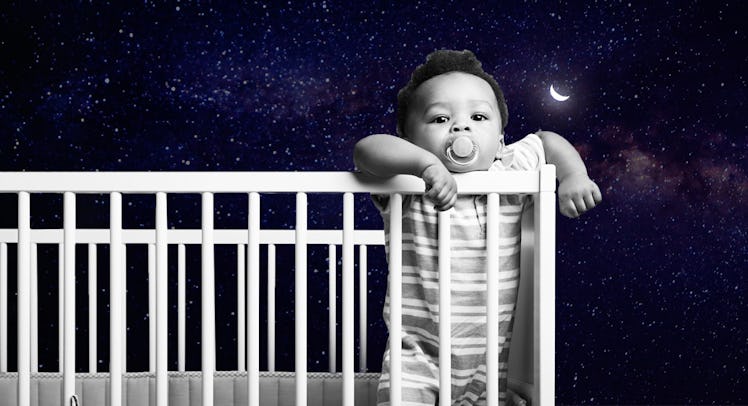What Is The 4-Month Sleep Regression?
One day, your infant is sleeping like, well, a baby. The next, the four-month sleep regression hits. Here's what you need to know.

Parents of newborns may be up at odd hours — waking up in the middle of the night for feedings and diapers — but they can usually count on opportunities to catch up on some zzzs, given that infants sleep about 16 hours a day for the first three months. During this hazy, blissful time, parents can bank on that sleep-training and settle, reasonably well-rested, into their new routine. Until… the dreaded 4-month sleep regression hits.
What is Baby Sleep Regression?
A sleep regression means, essentially, that an infant’s natural sleep patterns are evolving and causing them to wake more frequently, sleep less soundly, and transition with napping schedules. At 4 months, babies experience the first in a series of sleep regressions, which typically take place around 4 months, 9 months, and 18 months. These baby sleep regressions are developmentally appropriate, but they can be tough on parents: At 4 months, your baby’s circadian cycle shifts, and that brief but dreamy period of being relatively well-rested comes to a screeching halt.
What Causes Baby Sleep Regression?
Several things can cause a sleep regression, but the shift in sleep habits is most often attributed to the natural growth of a baby. New developments, such as crawling and teething, create changes in sleep patterns that facilitate those developments. In other words, your baby growing up can mean less sleep for you. You can, however, diminish the impact of sleep regressions by establishing good sleep habits off the bat.
Everything You Need to Know About the 4 Month Sleep Regression
At 4 months of age, babies start to get busy for the first time. They begin rolling over, squirming, and gaining more motor control. They also start to sleep less. During this time, instead of steaming through 16 hours of sleep, babies get closer to eight hours a night, uninterrupted, and can get away with four hours of napping spread throughout the day. Babies at this age begin to differentiate between night and day and start acclimating to the asleep-by-night/awake-by-day schedule that they’ll adhere to for the rest of their lives.
Until the 4-month mark, babies are on womb time, keeping to their in-utero sleep schedule. Infants in this early phase can drop immediately into a deeper non-REM sleep, says certified infant and child sleep consultant Pam Edwards, which is why you can rock or nurse a 2-month-old baby to sleep and put them down for a nap just about anywhere — the car, the living room, a football stadium — without any fear of waking them up. But once the 4 month sleep regression starts, babies no longer enter deep sleep as quickly and, like adults, can be easily roused within the first 30 minutes of falling asleep. So rocking, holding, and singing to a baby becomes stimulating — not sleep-inducing. Reducing all distractions, noise, light, and keeping a steady room temperature is imperative to beating the 4 month sleep regression.
In addition to controlling your child’s sleep environment, it’s important to get your baby on your schedule and stick to it, since this will be similar to the sleep schedule they are on for the rest of their lives. Think of this as sleep training 101. A baby who was previously sleeping in until 7 or 8 a.m. will begin to wake up at a more natural “sunrise” hour — around 6 or 7 a.m. Instead of hoping that a later bedtime will help a baby to sleep in a bit later, it’s important to put them to bed earlier in order to guarantee a (full) good night’s sleep. This will prevent a shorter sleep cycle from creating an overtired baby who will, in turn, wake up even earlier, more frequently, and grouchier. Get on board with the “early to bed, early to rise” pattern and stick to it — anything less is going against the baby’s natural sleep rhythms, according to family sleep consultant Hailee Schollaardt.
Aside from a natural adjustment to the circadian world around them, a baby’s physical development also contributes to changing sleep patterns. At 4 months, most babies become more mobile — making swaddling unsafe. But swaddling still promotes sleep, so you’re stuck between a sleepsack and a hard place. In this case, Edwards suggests trying the Baby Merlin’s Magic Sleepsuit (until they start rolling in their sleep). “It’s a fantastic tool for babies who aren’t able to be swaddled but just aren’t ready for a sleepsack quite yet,” writes Edwards in a post on the Wee Bee Dreaming sleep consulting site.
Promoting an early bedtime, creating a calm sleep environment, getting good naps, and switching up the way you swaddle will all help to prevent a 4 month old sleep regression from turning into sleep deprivation for the whole family. Just remember that sleep really isn’t that tricky — we all need it, and your baby wants it. Provide the schedule, environment, and guidance for good rest and it will come (not always right away, but it will come).
This article was originally published on